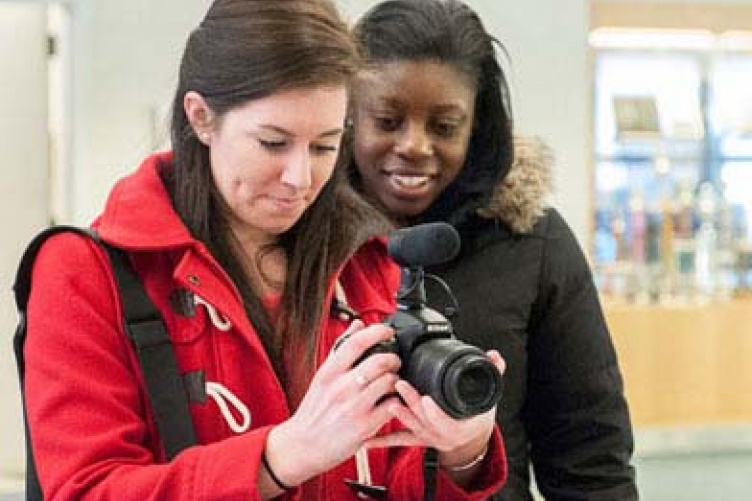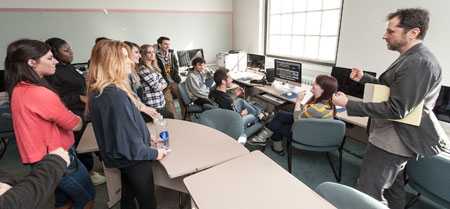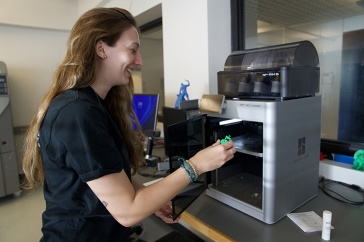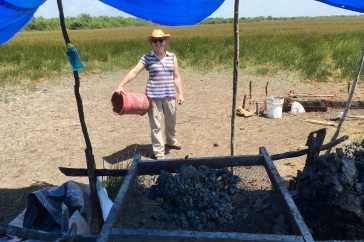
Breanna Edelstein ’14 (left) shares shots with Ericka Dupervil ’14 as they create a video for the 45-minute Film Festival in Tom Haines’s class.
Journalism has gone online, and the way we read, view, and understand news has transformed. Even the old “who, what, where, why, when, and how” has a different dynamic. Today, the reader enters the news realm as though ordering from an à la carte menu, choosing among a tweet, blog, slideshow, video, or article.
Tom Haines, who teaches Multimedia Storytelling this semester, thinks that this era is a heyday for journalists. While working at the Boston Globe from 2002 to 2009, Haines saw firsthand the many business challenges that the Internet posed to the traditional newspaper model. But he’s also seen the powerful potential of producing journalism for digital platforms as the Globe and other news organizations have evolved.
“Telling stories, reporting, checking facts, and having that work ethic, curiosity, and empathy — that’s still the same,” says Haines.
Now on Video!Shannon Reville ’14 created this video about UNH student Kevin Ennis ’15 Jake Deschuiteneer ’14 |
A veteran journalist, Haines has written for the Boston Globe, The Atlantic.com, The New York Times, The Seattle Times, and The Big Bend Sentinel, to mention a few. He has been named Travel Journalist of the Year in North America three times and his work has been anthologized in Best American Travel Writing.
Today, notes Haines, a key skill for journalists is the ability to create two-to three-minute video documentaries along with being able to write, tweet, and take great photos.
“For example, you might have a story about land use, but it could run with a short video about a farmer and what’s changed on his land,” says Haines. “Making those character-driven videos is what Multimedia Storytelling is about.”
Practice, Practice
On this particular day, the class will participate in a 45-minute Film Festival. Haines designed this fast-moving assignment to circumvent beginner’s butterflies. As students amble into the Donald Murray Journalism Lab they’ve got that wary but happy look — what is Haines up to today?
Since this course began in January, each student has learned to use an iPod Touch, a Nikon D5100 DSLR (digital single lens reflex camera), and to edit video with iMovie and sound with Garageband. They post their work on their own accounts in YouTube and Vimeo.
On the white board, Haines quickly writes out today’s class schedule: 20 minutes to find a story and report, 20 minutes to edit, and 5 minutes to polish. And then, says Haines, “It’s Showtime!”
|
Tom Haines, assistant professor of English, discusses camera techniques and the conversations that lead to great interviews. |
Five teams assemble quickly and hurry out the door. They disappear like frosty clouds of breathe. Who knows where they’ve gone on this quiet, mid-morning campus? Whose story will they report on in the next 20 minutes?
Most of the teams return on the dot, park themselves in front of big computer screens, and begin to edit with one eye on the clock. After the editing frenzy is over, Haines asks, “Who’s up?”
Annah Todd ’14 and Craig Harriman ’14 run a piece on WUNH. Clearly, they have a vision.
“You could go back and spend more time with them,” says Haines. “Get more B roll. Show the station in action. Include a few more characters. It has potential. A lot of important work happens before the camera is even turned on. But hey, we’re just jamming this through the food processor.”
Next it’s a HoCo egg extravaganza by Sam Burch ’15 and Steven Galante ’15.
“So you took it literally! You’ve got to break some eggs to make an omelet,” says Haines.
The varying rhythms of edits and shots are fun plus Burch and Galante speeded up the sequences.
“I like that you got behind the counter,” says Haines. “Access. It’s all about access and showing the viewer something new.”
Other videos include a waitress at Young’s Restaurant, a true-life tour of the food court, and a chat with the front desk person at the Hamel Rec Center.
“When you work in a news room, there’ll be a day when your editor says, ‘Hey go get me a story, any story,” says Haines. “You’ve got to embrace the awkwardness.”
|
|
Skill Sets
Perhaps the biggest challenge for students is to translate writing skills into visual and audio skills. Haines maps it out: research, interviewing/filming, rough draft/rough cut, and creating a final draft/final edit.
With each class, Haines changes it up: On another day, students analyze a professionally made video frame by frame to study shot composition and a range of film techniques.
To provide a window into the profession, Haines brings in guest speakers including UNH videographer Scott Ripley, award-winning filmmaker Dan Habib of the UNH Institute on Disability, and former Boston Globe colleagues, Essdras Suarez, a Pulitzer Prize photographer, and Dina Rudick, photographer, filmmaker, and videographer.
By April, Haines’s students will produce a final two-member team project and a solo project. By May, many will graduate.
Journalism students are a tough-minded bunch, and “The Plan” as some refer to it, is necessarily hazy. They have to hit the job market. All are clear that “being able to create and edit video is a required skill.” But they also have a new openness critical to good journalism. As one student wrote: “Now, I walk down the sidewalk and I hear individual layers: someone’s iPhone ringing, bus engines, leaves rustling, people talking, the slap of feet.” These students are ready to discover the world.
Originally published by:
-
Written By:
Staff writer | Communications and Public Affairs



















































